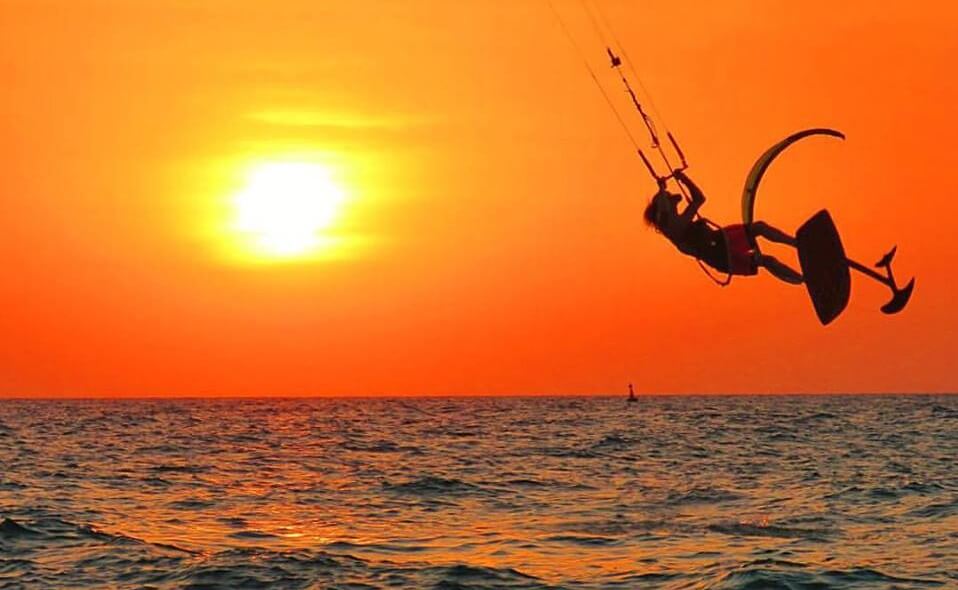KITESURFING HYDROFOIL LESSONS IN DUBAI
Prepare for your flight into the fastest growing sector of the kitesurfing hydrofoil market in Dubai, and even, the world!
Many kitesurfers who have already mastered kiting with twin tip boards or surf boards find themselves in need of a new challenge. You may even be one of those kitesurfers… well, hydrofoiling is the sport for you!
The magnificent hydrofoil board has a wind range that it beyond anything else you have seen or used, allowing you to be up and riding with a 14m2 kite in 8 knots or less, and continue riding well into 20 knots even with a smaller kite for sure.
The kitesurfing hydrofoil lessons are structured with the use of our purpose-built coaching equipment from Cabrinha Foiling Flight School in mind.
Our kitesurfing hydrofoil course is divided into 3 stages:

First hydrofoil lesson (stage 1) – 3 hours (1-hour lesson and 2 hours practice with 40 cm mast)
The main purpose of the short mast is to start to build your confidence with the foil board. In this lesson, you must aim to keep the board on the surface of the water as much as possible, and not allow the board to come out of the water. The reason for this is if you can control the board well enough to keep it on the surface of the water, you will be able to control it to stay above the water at any height you want. You’ll definitely find the balance on the board will change the higher you go.
Key points for the lesson:
- Move pressure from back foot to front foot!
- Release the bar!
- Bend your knees!
Second hydrofoil lesson (stage 2) – 3 hours (1-hour lesson and 2 hours practice with 60 cm mast).
With the medium size mast, the fun can really begin as you start to allow the board up and out of about 20-30 cm. During this lesson, you will learn to keep the kite steady at an angle of approximately 45 degrees whilst riding this board. Once you have the right speed to keep going, you will also begin to play with the power generated from slightly pulling or releasing the bar. In this lesson stage, the most exciting part of foiling starts as you learn to release the pressure from your front foot and get a lift from the foil.
Third hydrofoil lesson – 3 hours (1-hour lesson and 2 hours practice with the 85 cm mast) –
Now you’ll use the 85 cm mast, riding higher and with more speed than ever before.
KITESURFING HYDROFOIL LESSONS DURATION
The 9 hours of the hydrofoil lessons are usually run on Kitesurf Beach (Nessnass beach) where the water is deeper and the lessons can be run in any wind direction (offshore wind excluded). During your hydrofoil lesson for kite surfing, you will learn all of the basics that you will need to get up and ride on a foil.
KITESURFING HYDROFOIL LESSONS REQUIREMENTS
These kitesurfing hydrofoil lessons are only available to kitesurfers with previous experience – those who already have the ability to ride upwind, have good kite control and kite coordination.
| Kitesurfing hydrofoil Lessons & Rentals | Time | Cost | Book |
|---|---|---|---|
| Kite boarding hydrofoil package 3 hrs lessons & 6 hrs rental | 9 Hours | 1500 AED | BOOK |
| Kite boarding hydrofoil 1 hour lesson & 2 hours rental* | 3 hours | 600 AED | BOOK |
| Hydrofoil board rental** | 1 Hour | 150 AED | BOOK |
| Hydrofoil board rental** | 2 hours | 250 AED | BOOK |
| Hydrofoil board rental** | Half day | 500 AED | BOOK |
| Hydrofoil full gear rental** | 1 hour | 300 AED | BOOK |
| Hydrofoil full gear rental** |
2 hours | 500 AED | BOOK |
| Hydrofoil full gear rental** |
Half Day | 700 AED | BOOK |
* each hydrofoil session include 1-hour lesson and 2 hours of rental
** For kite surfers with previous hydrofoil experience
** Rentals requires a minimum experience in hydrofoil
KITESURFING HYDROFOIL LESSONS BREAKDOWN
Getting a feel for how your foil behaves is much easier and safer with a shorter mast. Staring with the 40cm mast will help you master basic foiling skills like:
- how to properly carry your foil
- how to swim and body drag with it
- how to get it in position to water start
- how to get it under your feet and moving through the water.
Body Drag First:
Developing this skill shouldn’t take long, but it’s an important step in getting a feel for the way the board will behave with a foil attached to it. For many, it will also be a necessary skill to get out to deeper water.
With your bottom hand, using your forearm and elbow for leverage, grab your front foot strap and hold your hydrofoil board with the foil at about a 45-degree angle in the water (if it’s deep enough).
Footstraps:
Straps assist in getting the board into position as you’re starting while keeping a loose fit helps you slip out of them when you crash.
Proper Starting Position:
Make sure the foil is at the surface of the water before attempting to start. Once in position, hold the foil horizontal with your feet in the straps, and use a gentle kite pull to keep you oriented in the proper direction.
The front of your board should be pointing moderately upwind (not downwind), to ensure a slow start once you’re out of the water. With a shorter mast, you’ll learn these basic steps much easier and safer than if you were struggling with a full-size setup.
Keep it level:
The overall objective at this stage is for your board to be level with the water. If the board is angled in any direction, the foil will accentuate the angle. Movements and changes in position should be subtle, starting from the hips. Small changes in posture translate to big changes in what the foil does.
Look Out Below:
Be careful not to kick the foil in the water. This might seem obvious, but it’s easy to forget the foil is down there as you maneuver it into position. You’ll also want to be careful of your board when you crash; it will carry more speed and distance than a surfboard or twin tip and can chase you down if you fall in front of it at speed.
Stay Close:
Try to stay about even with your starting/ending point as you get used to the foil. Staying upwind will come quickly since the foil acts like a giant fin. For beginners, riding downwind can be more challenging than staying upwind. Until you get the hang of it, stay as neutral as you can with your starting point, given the conditions and geography of where you are learning.
Once you’re able to taxi back and forth on the 40 cm mast, you will advance to the 60 cm mast. The 60 cm mast is an invaluable tool in accomplishing your first extended foil rides. As you rise and fall off of the water, you will begin to foil longer in between.
You will appreciate the easier handling a shorter mast provides and will be amazed at how quickly you get the hang of the differences in balance and kite control that foiling demands.
Once you’re able to taxi back and forth on the 60 cm mast and can ride short distances out of the water using the foil you will learn to:
Control speed and lift:
In this stage, you will learn how to control the speed that you are building for comfort. Picking up speed can happen quite suddenly and knowing how to stay in control can mean the difference between a soft touchdown and a major spill.
Kite control, front foot pressure, and proper edging are the three key factors. Bringing your kite slowly higher in the window will help you ease power from your kite. Strong front foot pressure will help control the lift that speed produces.
Edging hard upwind (if you’re ready) or letting off the foil and riding out the speed as you bring your kite to neutral will bring you back down to a comfortable speed.
Kick Free to Crash:
Crashes are inevitable. Whenever possible, kick-free from your board and crash as far away from it as possible. Being able to do this skill is the reason why you will be riding with your footstraps lose.

NOW THAT YOU HAVE THE BASICS AND ARE FLYING ON THE WATER, YOU CAN EITHER RENT OUR HYDROFOIL BOARDS OR GET YOUR 10% DISCOUNT FROM OUR KITESURFING HYDROFOILS COLLECTION!
Tips
Ready to hit the water? Use the same kite size you would for a normal kiteboarding session so that you don’t have to focus as much on the kite power and concentrate only on the foil. Let’s go:
- If your kiteboard allows it, get the foil at the furthest most backward setting on the box so that you develop muscle memory and shorten your learning curve, as moving the mast forward will make the board come out of the water very fast.
- Loosen your foot straps, as this will help you to eject totally from the board when you wipe out.
- Ready to hit the water? Always carry the foil like a surfboard, as close to the foil mast as possible, and the foil on the upwind side of your body.
- Walk to deep water while trying to prevent the foil from hitting the ocean floor.
- When body dragging, hold on to the front foot strap with your leeward/backhand. Once you’ve reached deep water, be sure to be conscious of the foil’s position, and get yourself on the upwind side of the board.
- Are you in deep water? Let’s water start. Grab your front foot strap with your backhand, pulling towards your body, while pushing down with your elbow and pointing the foil towards the surface of the water – this will get the foil in the prime starting position.
- Once on the rail, begin the water start. You’ll experience a whole new sensation, even with the foil moved backward, i.e. in beginner mode.
- Foil kiteboarding requires additional front foot pressure compared to the classic ways of riding a kite, so make sure you step on the gas pedal.
If you feel you’re ready to foil in advanced mode, move the wing an inch forward on the track. You’ll feel more lift in the water, and constant ups and downs of the board.
As you get used to it, your body will automatically make the necessary weight adjustments to get the foil gliding perfectly over the water.

